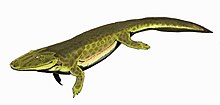Tulerpeton
|
Tulerpeton Temporal range: Late Devonian |
|
|---|---|
 |
|
| Scientific classification | |
| Kingdom: | Animalia |
| Phylum: | Chordata |
| Class: | Amphibia sensu lato |
| Order: | Ichthyostegalia |
| Family: |
Tulerpetontidae Lebedev & Coates, 1995 |
| Genus: |
Tulerpeton Lebedev, 1984 |
| Binomial name | |
|
Tulerpeton curtum Lebedev, 1984 |
|
Tulerpeton is a fossil of an extinct genus of Devonian labyrinthodont that was found in the Tula Region of Russia at a site named Andreyevka. This genus and the closely related Acanthostega and Ichthyostega represent the earliest tetrapods.
Tulerpeton is considered one of the first true tetrapods to have arisen. It is known from a fragmented skull, the left side of the pectoral girdle, and the entire right forelimb and right hindlimb along with a few belly scales. This species is differentiated from the less derived "aquatic tetrapods" (such as Acanthostega and Ichthyostega) by a strengthened limb structure. These limbs consist of 6 toes and fingers. Additionally, its limbs appear to have evolved for powerful paddling rather than walking.
The fossil fragments also indicate that its head was disconnected from the pectoral girdle. From the absence of the rough postbranchial lamina of the pectoral girdle, it has been determined that Tulerpeton had no gills and was therefore entirely dependent on breathing air.
Tulerpeton lived approximately 365 million years ago, in the Late Devonian period when the climate was fairly warm and there were no glaciers. Land had already been colonized by plants. During the Devonian period, the first truly terrestrial tetrapods – the ancestors of present-day reptiles, birds, amphibians and mammals - first began to appear.
Even though Tulerpeton breathed air, it lived mainly in shallow marine water. The Andreyevka fossil bed where it was discovered was at least 200 km from the nearest landmass during this era. The fossils of plants in the area tell us that the salinity of the waters where it lived fluctuated wildly, indicating that the waters were quite shallow. Because the bones of the neck and the pectoral girdle were disconnected, Tulerpeton could lift its head. Therefore, in shallow water, it had a considerable advantage over the other animals whose heads only moved side to side. The later land animals that descended from Tulerpeton’s relatives needed this head flexion on land, but the condition probably evolved because of the advantage that this gave it in shallow marine waters, not for land. In the book “Vertebrate Life”, authors Pough, Janis, and Heiser say that,” The development of a distinct neck, with the loss of the opercular bones and the later gain of a specialized articulation between the skull and the vertebral column (not yet present in the earliest tetrapods), may be related to lifting the snout out of the water to breath [sic?] air or to snap at prey items.” The six fingered hands and toes were stronger than the fins from which they developed, therefore “tulerpeton” had an advantage in propelling itself through shallow and brackish water, but the limbs do not yet seem strong enough for extensive use on land.
...
Wikipedia
